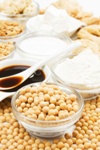 In part three of my look at soy, I hone in on its possible effects on bones. Our skeletons are critical, obviously, but the ravages of osteoporosis are widespread in society. Maybe the legume soy could be the food cure that does the trick.
In part three of my look at soy, I hone in on its possible effects on bones. Our skeletons are critical, obviously, but the ravages of osteoporosis are widespread in society. Maybe the legume soy could be the food cure that does the trick.
Isoflavones, a major constituent in soy, are a subclass of flavonoids with a chemical structure similar to “17 beta-estradiol,” which is the most potent, naturally occurring estrogen in man. The main isoflavones in soybeans include genistein, diadzein, and glycitein.
The use of phytoestrogens to preserve bone mass and prevent or delay the onset of osteoporosis has been studied only starting in the late 1990s. Here’s a look at some of the promising findings here:
A study of 66 postmenopausal women compared moderate to high isoflavone intake for 26 weeks. It found that bone density increased with the high isoflavone diet.
A study of 69 perimenopausal women compared an isoflavone-rich diet to a poor one for 24 weeks. Those eating isoflavones a lot reduced bone loss.
Another study on nearly 500 postmenopausal women found that eating high isoflavone content increased bone mass.
One three-year study on 132 perimenopausal women found that soy had significant effects on the maintenance of bone density.
An important confounding factor in these studies with isoflavone supplementation is the fact that there is quite a bit of variability in both the absorption as well as chemical processing of isoflavones among subjects in terms of metabolism, namely low, moderate and high metabolizers of soy insoflavone. It is not surprising to find that, given the same dose of isoflavone, there is variability in the bone
density responses. Therefore, there is an urgent need to conduct more double-blind, placebo-controlled studies that are longer in duration (two to three years) using different doses of isoflavones in the near future.
In medical literature, there is preliminary evidence that soy products may benefit the following other conditions:
— Improvement in glucose control in type 2 diabetes
— Reduction in breast cancer risk
— Reduction in the risk of prostate cancer
— Reduction in exercise-induced muscle soreness
Read my previous articles on the benefits of soy:
